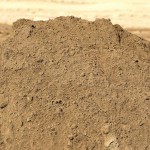
In December 2011, the revelation that the 132 Freeway right-of-way on the west side of Modesto contains waste sites containing toxic barium made newspaper headlines. Caltrans wants to build a freeway over the sites without removing the toxic soil, even though some of the mounds are adjacent to a residential neighborhood.
On Wednesday, November 28, 2012, experts from Geocon, a private contractor that conducts water tests, reported to public officials during a meeting at the toxic waste site that well water underneath the site contains amounts of barium that are safe for public consumption. The purpose of the meeting was to assure the public that the concentration of toxic waste in well water presently poses no health hazards.
Geocon is a widely respected testing organization, known for accuracy and impartiality. Therefore, the data obtained from the tests should be deemed accurate by critical thinkers. However, the conclusion that the sites are safe regarding public health issues is suspect because of the manner in which information is being released and because of a number of unknown facts.
Caltrans spokesperson Ms. Sam Haack was not forthcoming when asked questions by Mr. Scott Calkins, a member of the Stanislaus Council of Governments Citizens’ Advisory Committee. Mr. Calkins said that he could get little information beyond what Caltrans wanted those in attendance to know.
For example, the meeting and tests were conducted during a rain storm. Mr. Calkins noted that water was running off one of the toxic waste piles, into the gutter on Emerald Avenue, and flowed down the street where it entered a city storm drain. When Mr. Calkins asked about the drainage, he was assured that the water was to be kept on site and not allowed to drain into surrounding areas even though this clearly was not the case.
The soil in the toxic waste sites came from the bottom of settling ponds at the old FMC industrial site. How toxic is the soil in and around the present sites? Ms. Haack and a Caltrans geologist provided no information about soil tests.
How certain is science that the safety threshold levels established by the California Water Quality Board for barium and other heavy metals adequately reflect the dangers posed by the materials? Is it possible that some people are much more sensitive to exposure to barium than others?
Julie Brughelli is a longtime resident living within a mile of the toxic sites. She compiled a list of nearly one hundred current and former nearby residents who had illnesses that could possibly be linked to the presence of toxic waste in the sites. The illnesses include various forms of cancer, appearing in clusters over a period of forty years. However, Ms. Brughelli is not a scientist and has no way to scientifically link the toxic waste sites to the illnesses. She made the list available to public officials months ago. Is anyone in a position to take action doing a study?
How does one account for the apparent coincidence of large numbers of residents living near the toxic waste sites experiencing severe health problems? In the past, how often have owners of toxic waste sites underestimated the damage done to neighbors by their land use? What are the odds that the 132 right of way sites are totally safe?
What the People can Expect
Given the history of the 132 freeway toxic waste sites, citizens can expect the negative impacts of the sites to be downplayed. Since it’s impossible to visually see damage done by the toxic waste within the sites, expect advocates to provide assurance that everything is safe. What one cannot see can be harmful.
Caltrans does not want to pay the cost to move the toxic soil to a primary or secondary waste disposal dump. In fact, the soil may be so toxic that it is unsafe to move. Therefore, using insufficient data, samples or incomplete science, the agency may try to convince local leaders and the public that all is safe and that the sites can be paved over with no future negative health consequences for nearby residents. Hopefully, Caltrans will be totally honest.
What the People Should Insist On
Given the lack of information coming from Caltrans, we should assume the worst. All contaminated soil should be removed from the toxic waste sites to lawful disposal locations before the freeway is built, period. If the soil cannot be moved, then all neighboring property should be acquired by Caltrans to establish a buffer zone between the sites and residences. Citizens damaged from years of exposure to material within the sites should be made whole. The people of Modesto should settle for no less.
